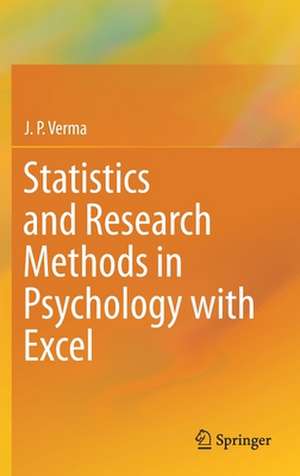Statistics and Research Methods in Psychology with Excel
Autor J. P. Vermaen Limba Engleză Hardback – 5 sep 2019
Preț: 967.56 lei
Preț vechi: 1179.96 lei
-18% Nou
Puncte Express: 1451
Preț estimativ în valută:
185.16€ • 201.06$ • 155.54£
185.16€ • 201.06$ • 155.54£
Carte tipărită la comandă
Livrare economică 22 aprilie-06 mai
Preluare comenzi: 021 569.72.76
Specificații
ISBN-13: 9789811334283
ISBN-10: 9811334285
Pagini: 582
Ilustrații: XXIX, 619 p. 165 illus., 109 illus. in color.
Dimensiuni: 155 x 235 mm
Greutate: 1.08 kg
Ediția:1st ed. 2019
Editura: Springer Nature Singapore
Colecția Springer
Locul publicării:Singapore, Singapore
ISBN-10: 9811334285
Pagini: 582
Ilustrații: XXIX, 619 p. 165 illus., 109 illus. in color.
Dimensiuni: 155 x 235 mm
Greutate: 1.08 kg
Ediția:1st ed. 2019
Editura: Springer Nature Singapore
Colecția Springer
Locul publicării:Singapore, Singapore
Cuprins
Chapter 1. Importance of Statistics in Psychology.- Chapter 2. Measurement and Scaling Techniques.- Chapter 3. Descriptive Analysis of Psychological Data.- Chapter 4. Graphical Presentation of Data.- Chapter 5. Probability and its Application in Psychology.- Chapter 6. Normal Distribution and its Application.- Chapter 7. Correlation and Regression Techniques.- Chapter 8. Sampling Techniques.- Chapter 9. Research Design in Psychology.- Chapter 10. Statistical Inference.- Chapter 11. Analysis of Variance.- Chapter 12. Non-parametric Tests for Psychological Data.- Chapter 13. Non-parametric Correlations.- Chapter 14. Application of Factor Analysis in Psychological Data.
Notă biografică
Prof. J. P. Verma is currently working as Dean Students Welfare and Head, Department of Sports Psychology at Lakshmibai National Institute of Physical Education (LNIPE), Gwalior, India. He also worked as Director, Centre for Advanced Studies at the institute. Prof. Verma is a triple Masters – in Statistics, Psychology and Computer Application, besides a PhD in Mathematics, and has an experience of more than thirty six years in teaching and research. He has published about nine books with leading publishers like Wiley, Springer, McGraw Hills on research and statistics in the area of management, exercise science, health, sports and physical education. He has a patent to his credit on FitnessWatch (a fitness assessment and management system for school children and youth). This know-how was validated by the independent body appointed by the LNIPE with the grant of Ministry of Youth Affairs and Sports, Government of India. Prof. Verma was a visiting fellow in the University of Sydney in 2002. He has undertaken academic visits to institutions in Bulgaria, Qatar, Australia, Poland and Scotland, and where he has conducted numerous workshops on research methodology, research designs, multivariate analysis, and data modeling in the area of management, social sciences, physical education, sports sciences, economics, and health sciences.
Textul de pe ultima copertă
This book, specifically developed for students of psychology, covers a wide range of topics in statistics and research designs taught in psychology, in particular, and other disciplines like management, sociology, education, home science, and nutrition, in general, in most universities. It explains how to use Excel to analyze research data by elaborating statistical concepts. Each chapter contains sections like “Check you Computing skill” and “Check your Statistical Concepts” to enable students to assess their knowledge in a graded manner.
The book addresses one of the major challenges in psychology research, viz., how to measure subjective phenomenon like attitude, desire, and preferences of an individual. Separate emphasis has been given to the measurement techniques which are essential tools to assess these subjective parameters in numerical form, required for statistical analysis to draw meaningful conclusions. The book is equally helpful to studentsof humanities, life sciences and other applied areas. Consisting of 14 chapters, the book covers all relevant topics of statistics and research designs which are important for students to plan and complete their research work.
Caracteristici
Discusses with examples most of the parametric and non-parametric tests, including non-parametric correlations Contains Excel application towards the end of each chapter to facilitate researcher to analyze their data using different statistical techniques using Excel Requires only elementary knowledge of mathematics and no prior knowledge of statistics to understand the concepts included Contains sections, exercises and additional resources useful for students and instructors
